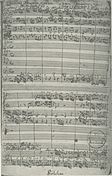Wikipedia:Main Page history/2023 February 7
From today's featured article
Jesus nahm zu sich die Zwölfe ('Jesus gathered the Twelve to Himself'), BWV 22, is a church cantata by Johann Sebastian Bach, written for the last Sunday before Lent. He composed it as an audition piece for the position of director of church music in Leipzig, and he first performed it there in a church service at the Thomaskirche on 7 February 1723. The work begins with a scene from the Gospel in which Jesus predicts his suffering in Jerusalem, and is not understood by his disciples. Bach showed, setting the prescribed text of an unknown poet, that he mastered the composition of a dramatic scene, an expressive aria with obbligato oboe, a recitative with strings, an exuberant dance, and a chorale in the style of Johann Kuhnau, his predecessor in Leipzig. According to the Bach scholar Richard D. P. Jones, several elements of the work such as a "frame of biblical text and chorale around the operatic forms of aria and recitative" became standards for Bach's Leipzig cantatas and even his Passions. (Full article...)
Did you know ...

- ... that a heavily modified Monotron synthesizer (PCB pictured) was nicknamed "FrankenSynth" by music resource site Ask.Audio?
- ... that the 1834 Philadelphia race riot began at a carousel before spreading to other parts of the city?
- ... that the May Queen dress worn by Florence Pugh in the film Midsommar was made of 10,000 silk flowers and reportedly sold for US$65,000 at auction?
- ... that William J. McGee said that the 2022 Southwest Airlines flight delays were the result of "appearing to regulate rather than actually regulating"?
- ... that the contest of the 1830 Liverpool by-election was considered to be "in great measure a personal one"?
- ... that Berta Berkovich, who was skilled in sewing, managed to survive Auschwitz in a fashion salon established by the wife of the concentration camp commandant?
- ... that the 1931 Valentine earthquake was the strongest earthquake in recorded history to hit Texas?
- ... that Kangal can be a hazard to cyclists in Turkey?
In the news

- An earthquake (damage pictured) strikes Turkey and Syria, killing more than 4,800 people and injuring nearly 24,000 others.
- Former Pakistani president Pervez Musharraf dies at the age of 79.
- A Chinese balloon suspected of surveillance and espionage is shot down after overflying Canada and the United States.
- Comet C/2022 E3 (ZTF) makes its closest approach to the Earth.
- A suicide bombing in a mosque in Peshawar, Pakistan, kills 100 people and injures more than 220 others.
On this day
- 1813 – Napoleonic Wars: Two evenly matched French and British frigates fought for four hours at the Îles de Los off the Guinean coast, resulting in a stalemate.
- 1900 – A Chinese immigrant in San Francisco fell ill with the bubonic plague in the first epidemic of the disease in the continental United States.
- 1943 – World War II: Japan successfully withdrew its troops from Guadalcanal.
- 2014 – Researchers announced the discovery of the Happisburgh footprints (pictured) in Norfolk, England, the oldest known hominid footprints outside Africa at more than 800,000 years old.
- Azar Bigdeli (b. 1802)
- Eddie Izzard (b. 1962)
- Juwan Howard (b. 1973)
Today's featured picture

|
|
Suffren was a predreadnought battleship built for the French Navy and completed in 1902. The ship was assigned to the Mediterranean Squadron for most of her career and often served as a flagship. She twice collided with French ships and twice had propeller shafts break before the start of World War I in 1914. Suffren was assigned to the naval operations off the Dardanelles, participating in a series of attacks on Ottoman fortifications. She was moderately damaged on 18 March 1915 and was sent to Toulon for repairs. She returned to provide gunfire support for the Allied forces during the Gallipoli campaign. Suffren provided covering fire as the Allies withdrew from the peninsula and accidentally sank one of the evacuation ships. She was then assigned to the squadron tasked to prevent Greek interference with Allied operations on the Salonica Front. While en route to Lorient for a refit, Suffren was torpedoed off Lisbon by a German submarine on 26 November 1916 and sunk with all hands. This photograph shows Suffren off Toulon in October 1911. Photograph credit: Agence Rol; restored by Adam Cuerden
Recently featured:
|
Other areas of Wikipedia
- Community portal – The central hub for editors, with resources, links, tasks, and announcements.
- Village pump – Forum for discussions about Wikipedia itself, including policies and technical issues.
- Site news – Sources of news about Wikipedia and the broader Wikimedia movement.
- Teahouse – Ask basic questions about using or editing Wikipedia.
- Help desk – Ask questions about using or editing Wikipedia.
- Reference desk – Ask research questions about encyclopedic topics.
- Content portals – A unique way to navigate the encyclopedia.
Wikipedia's sister projects
Wikipedia is written by volunteer editors and hosted by the Wikimedia Foundation, a non-profit organization that also hosts a range of other volunteer projects:
-
Commons
Free media repository -
MediaWiki
Wiki software development -
Meta-Wiki
Wikimedia project coordination -
Wikibooks
Free textbooks and manuals -
Wikidata
Free knowledge base -
Wikinews
Free-content news -
Wikiquote
Collection of quotations -
Wikisource
Free-content library -
Wikispecies
Directory of species -
Wikiversity
Free learning tools -
Wikivoyage
Free travel guide -
Wiktionary
Dictionary and thesaurus
Wikipedia languages
This Wikipedia is written in English. Many other Wikipedias are available; some of the largest are listed below.
-
1,000,000+ articles
-
250,000+ articles
-
50,000+ articles


